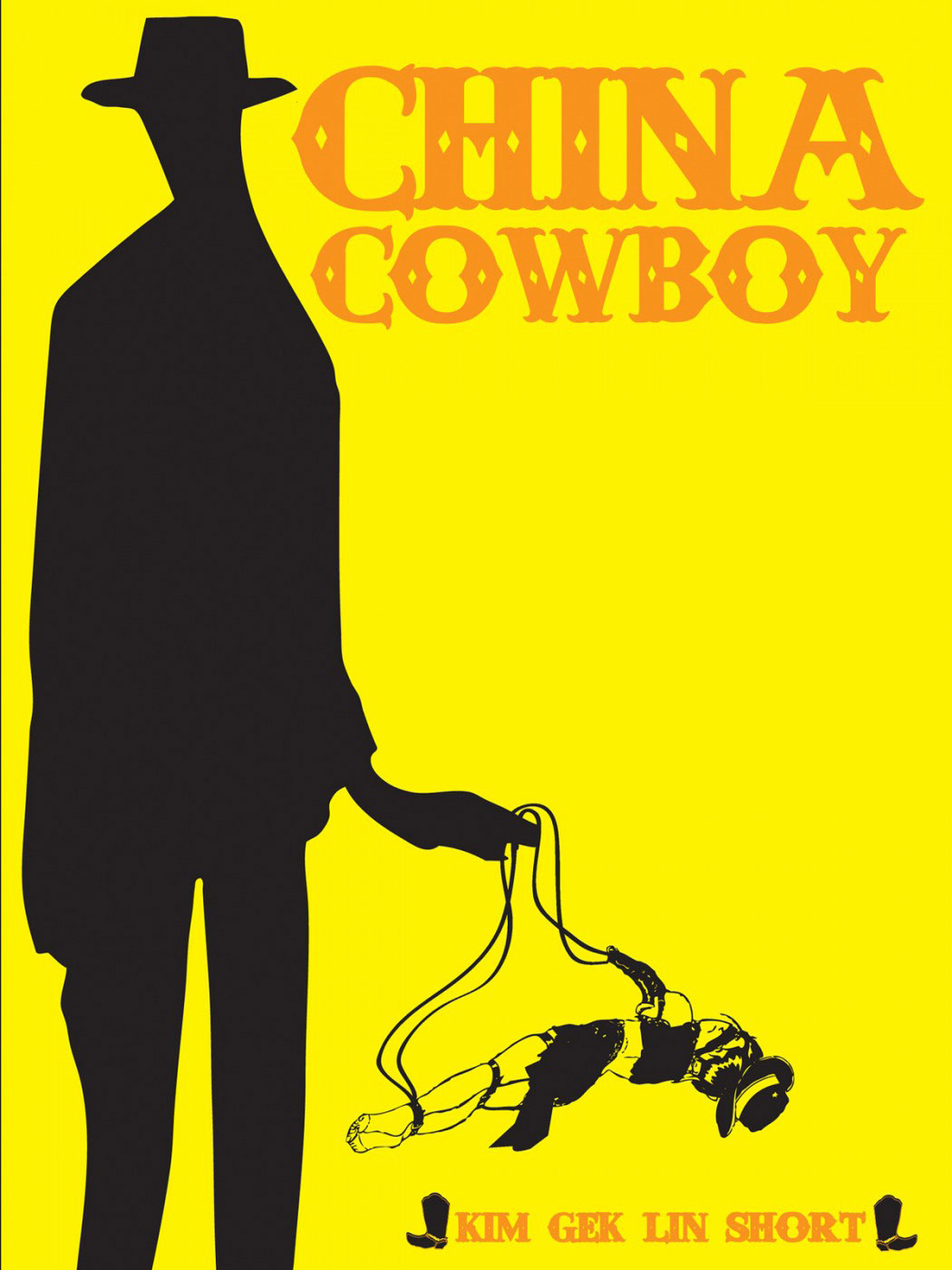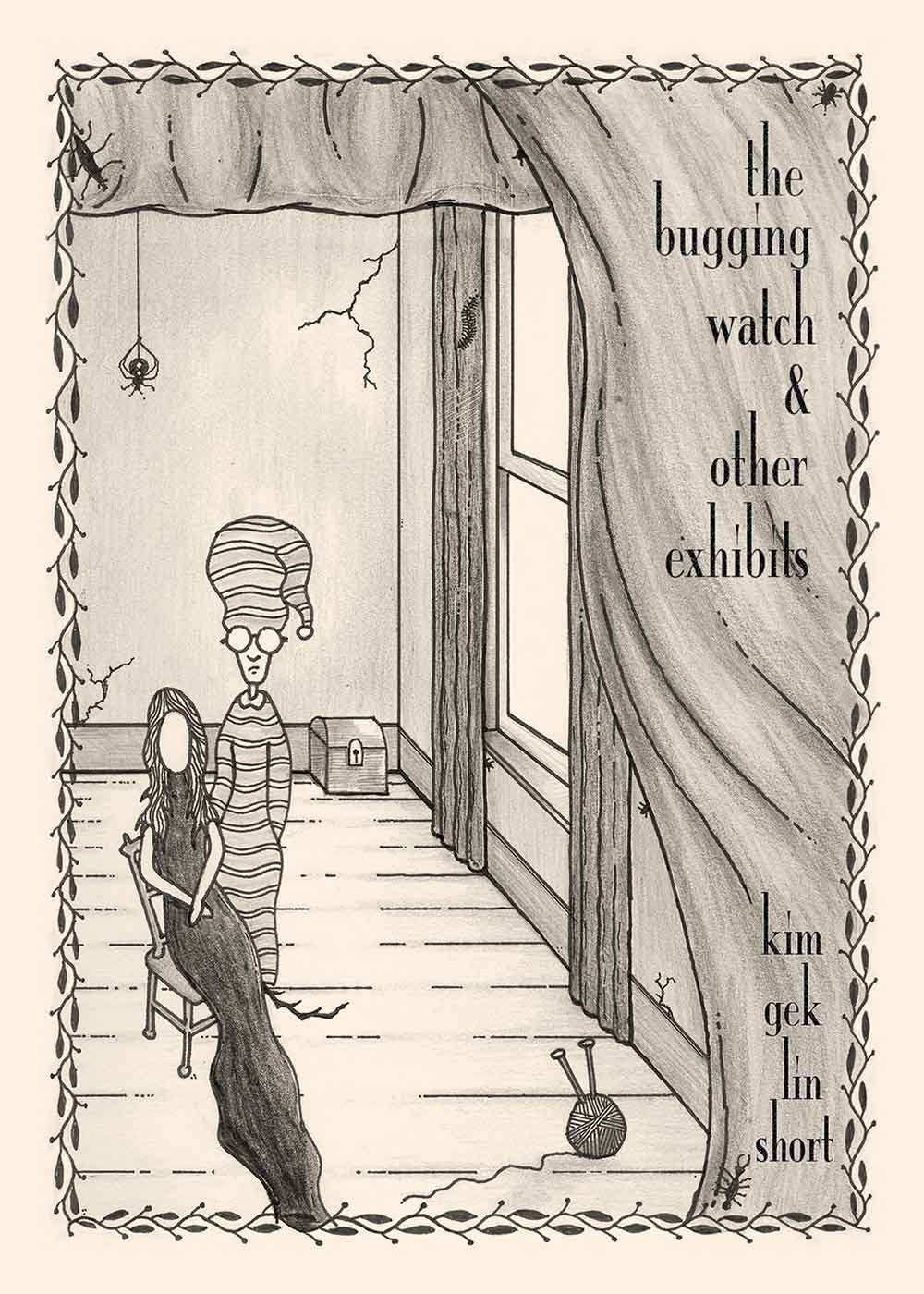Kim Gek Lin Short


Kim Gek Lin Short

China Cowboy
by Kim Gek Lin Short
Lyric Novel. 132 pages. Paperback. 2012
Cover design: Andrew Shuta
In the technicolor timewarp called Hell, Hong Kong, wannabe cowgirl La La is hellbent on realizing her dream to be a folk-singing sensation, even if it means surviving a dysfunctional relationship with her kidnapper, Ren, who is just hellbent. Ren thinks he’ll win, but La La, dead or alive, always wins.

China Cowboy
by Kim Gek Lin Short
Lyric Novel. 132 pages. Paperback. 2012
Cover design: Andrew Shuta
In the technicolor timewarp called Hell, Hong Kong, wannabe cowgirl La La is hellbent on realizing her dream to be a folk-singing sensation, even if it means surviving a dysfunctional relationship with her kidnapper, Ren, who is just hellbent. Ren thinks he’ll win, but La La, dead or alive, always wins.
Born in Hong Kong to a family of thieves, La La survives by giving herself fully to her religion—Americana. Her saints: Loretta Lynn and Clint Eastwood. Even after being kidnapped and brutally tortured by one of her family’s victims—ironically a farmer from Missouri named Ren—she asks herself, “what would Patsy Cline do?” The answer: “she’d belt every song in that / scratchy face.” … This fragmented narrative chronicles their dreams, delusions, and horrific physical lives. La La and Ren are as searing as any characters I’ve encountered—Henry and Mr. Bones, Lolita and Humbert Humbert, Hannibal Lecter and Buffalo Bill…. (Chris Tonelli) Short is an elegant, entrancing writer, and her second book-length collection is both devastating and uncomfortably enjoyable. (Megan Milks, American Book Review) A satanically intricate narrative with seemingly infinite vantage points in space, time and sympathy … has expanded and fused the poetic and narrative fields, creating a zone where elegance and grace can gambol with the just-plain-fucked-up. (Sarah Heady, HTML Giant) …grossly disturbing and excruciatingly seductive, catching the reader in a tense push and pull with and against the text. Sticky and stuck among the fucking and fucked-up, Short binds us within tales of fierce femme survival…. (Jai Arun Ravine, The Lantern Review) As savage as it is entertaining…. a marvel of modern storytelling, [with] characters whose stories will haunt you long after you finish the book, and will more than likely draw you back for another read. (John Deming and Steven Karl, Coldfront “Top 40 Poetry Books of 2012”) Bring[s] the reader to the brink of every sensory extreme and back again … a darkly surreal adventure in perception that leaves one’s nerves exposed and moral fortitude shaken. (Travis Macdonald, Fact-Simile) China Cowboy pulls me deep into “the belly of Hell,” a genre- and voice-switching push-and-pull that La La with her indomitable will refuses to give way to…. La La may be victimized, but she never submits…. I want every child to own such unyielding puissance; I want it for me, too. (Marthe Reed, OPEN / Horse Less Press) Moving between the explicit descriptions of the Marquis de Sade and the implicit ironies of Nabokov, these pieces are excruciatingly compelling, so infernal as they are related in languages variously pornographic and desperately, radically tender. Short’s brilliant tragicomedy can be read as a metaphor for China’s dynamic with American culture or the story of any determined enterprising youth whose eager “bloody head” under a bumbling tyrant’s “boot is bent.” A bold, imaginative, timely work from a courageous and complex thinker. (Heidi Lynn Staples) Heated & heartbreaking, China Cowboy charms like wedding cans, flesh-filled, on tarmac. This car (perhaps an old, long Cadillac with longhorns glaring & charred) contains a man, Ren: a “family man” or “something commensurate.” La-La: our heroine. & the driver, guiding us expertly over the bluegrass, bodies & Time Warps of Hell, child abuse, power & Country Music is Kim Gek Lin Short. (Rauan Klassnik) China Cowboy is more hydra than hybrid, a slim monster sprouting new directions for form, narrative, culture, and identity. Meanwhile, everything it bites comes to vicious, gorgeous life. (Christian TeBordo)
Born in Hong Kong to a family of thieves, La La survives by giving herself fully to her religion—Americana. Her saints: Loretta Lynn and Clint Eastwood. Even after being kidnapped and brutally tortured by one of her family’s victims—ironically a farmer from Missouri named Ren—she asks herself, “what would Patsy Cline do?” The answer: “she’d belt every song in that / scratchy face.” … This fragmented narrative chronicles their dreams, delusions, and horrific physical lives. La La and Ren are as searing as any characters I’ve encountered—Henry and Mr. Bones, Lolita and Humbert Humbert, Hannibal Lecter and Buffalo Bill…. (Chris Tonelli) Short is an elegant, entrancing writer, and her second book-length collection is both devastating and uncomfortably enjoyable. (Megan Milks, American Book Review) A satanically intricate narrative with seemingly infinite vantage points in space, time and sympathy … has expanded and fused the poetic and narrative fields, creating a zone where elegance and grace can gambol with the just-plain-fucked-up. (Sarah Heady, HTML Giant) …grossly disturbing and excruciatingly seductive, catching the reader in a tense push and pull with and against the text. Sticky and stuck among the fucking and fucked-up, Short binds us within tales of fierce femme survival…. (Jai Arun Ravine, The Lantern Review) As savage as it is entertaining…. a marvel of modern storytelling, [with] characters whose stories will haunt you long after you finish the book, and will more than likely draw you back for another read. (John Deming and Steven Karl, Coldfront “Top 40 Poetry Books of 2012”) Bring[s] the reader to the brink of every sensory extreme and back again … a darkly surreal adventure in perception that leaves one’s nerves exposed and moral fortitude shaken. (Travis Macdonald, Fact-Simile) China Cowboy pulls me deep into “the belly of Hell,” a genre- and voice-switching push-and-pull that La La with her indomitable will refuses to give way to…. La La may be victimized, but she never submits…. I want every child to own such unyielding puissance; I want it for me, too. (Marthe Reed, OPEN / Horse Less Press) Moving between the explicit descriptions of the Marquis de Sade and the implicit ironies of Nabokov, these pieces are excruciatingly compelling, so infernal as they are related in languages variously pornographic and desperately, radically tender. Short’s brilliant tragicomedy can be read as a metaphor for China’s dynamic with American culture or the story of any determined enterprising youth whose eager “bloody head” under a bumbling tyrant’s “boot is bent.” A bold, imaginative, timely work from a courageous and complex thinker. (Heidi Lynn Staples) Heated & heartbreaking, China Cowboy charms like wedding cans, flesh-filled, on tarmac. This car (perhaps an old, long Cadillac with longhorns glaring & charred) contains a man, Ren: a “family man” or “something commensurate.” La-La: our heroine. & the driver, guiding us expertly over the bluegrass, bodies & Time Warps of Hell, child abuse, power & Country Music is Kim Gek Lin Short. (Rauan Klassnik) China Cowboy is more hydra than hybrid, a slim monster sprouting new directions for form, narrative, culture, and identity. Meanwhile, everything it bites comes to vicious, gorgeous life. (Christian TeBordo)

The Bugging Watch & Other Exhibits
by Kim Gek Lin Short
Lyric Novel. 72 pages, Paperback. 2010
Cover art by Daniel Rhodes
The Bugging Watch & Other Exhibits is the prose elegy of a boy who wants to be a bug in order to save by symbiosis the dead girl he loves. Can Harlan, in “the basement forever inside him,” conjure Toland back from “the scars of Monday”? Enacted in prose poems and cross-referenced datebooks, the inseparable lovers, Harlan and Toland, eternally rehearse for a real life together, repeating in that instant between being and nonbeing, the loss into which their love escaped.

The Bugging Watch & Other Exhibits
by Kim Gek Lin Short
Lyric Novel. 72 pages, Paperback. 2010
Cover art by Daniel Rhodes
The Bugging Watch & Other Exhibits is the prose elegy of a boy who wants to be a bug in order to save by symbiosis the dead girl he loves. Can Harlan, in “the basement forever inside him,” conjure Toland back from “the scars of Monday”? Enacted in prose poems and cross-referenced datebooks, the inseparable lovers, Harlan and Toland, eternally rehearse for a real life together, repeating in that instant between being and nonbeing, the loss into which their love escaped.
A strange romance of “the secret motions of things” (Francis Bacon, The New Atlantis, 1627), Kim Gek Lin Short’s The Bugging Watch and Other Exhibits is an exciting, mysterious, sometimes macabre new narrative. Her zany futuristic gothic opera of prose poems is threaded with magic, potions, passion, a “concert of hair,” a “hazmat of holes.” With its incantations of quantum teleology, its footnotes & sources, it is a magnificent work. Irresistible! (Norma Cole) A luminous and perverse fairy-tale to be read at the beginning of the day, preferably in that “chilly blue hour before 4 a.m.” Complete with footnotes, diagrams and an “unspeakable private crevice,” these prose “exhibits” display a prebiotic potential. What was “not quite alive,” becomes, in this swift, dark telling, “hot anyway,” “enchantment created inside everything,” and sometimes: “a poem about bugs.” Angels, lab technicians from the suburbs of Denver, men in ratty satin capes and artisans of all kinds populate this stunning and strange narrative, which is not a narrative: it is a “growing hole.” Enacting the desire and curiosity the book prompts, a reader might peer in, fall for a long time, then “miraculously return.” I repeat: do not read this book at night. If you do, I can’t—the book can’t—account for your new dreams. (Bhanu Kapil) This small unsettling book first proposes a stiflingly sweet symbiosis between two shut-in innamorati, and then lets its queer world subdivide in a theater of exfoliating roles. Most shocking in this miniature is the Rosebud at its center, a muse who breaks with her mate only to reinvent him out of bugs, ink and sugarwater. Like a Victorian photo collage mounting, say, the head of Prince Albert on a croquet mallet or umbrella handle, The Bugging Watch both conceals and reveals its morbidity, its twisted thirsts. (Joyelle McSweeney) I kept thinking: Catacomb Valentine. Sometimes we forget that ancient catacombs were mapped, negotiated—which is to say: read—by the placement of the graves of paupers. The tunnel diggers constellated this grammar so they would know how to navigate and create within lush darkness. The Bugging Watch & Other Exhibits, in its way, deeply reminds. The network of tunnels—between lives, between being (blink) and not being (blink)—and all papered with valentines, the sort cut from thick, mealy-colored childhood stock. Here is language as enchantment. (Selah Saterstrom) Short’s prose poems have the exactitude of obsessive compulsion, yet the imagery and dimness of an opiate trip sponsored by Lewis Caroll. . . . She frequently stretches the parameters of grammar, rearranging conventional syntax to just off kilter; her written style as surreal as her yarn-and-insect imagery. The result is a terrifying, ungraspable split-level love story: futile, sad and beautiful. (Jeremy Benson, NewPages) A beguiling and entirely enthralling collection of related prose poems . . . so unusual and provocative in its subtle oddities that I wonder how aware she is of what she’s done. . . . It is what you think when you read a story by George Saunders, or see a film by David Lynch, or flip through a comic by R. Crumb: how did this person know he could do this? (Ben Gottlieb, Art + Culture)
A strange romance of “the secret motions of things” (Francis Bacon, The New Atlantis, 1627), Kim Gek Lin Short’s The Bugging Watch and Other Exhibits is an exciting, mysterious, sometimes macabre new narrative. Her zany futuristic gothic opera of prose poems is threaded with magic, potions, passion, a “concert of hair,” a “hazmat of holes.” With its incantations of quantum teleology, its footnotes & sources, it is a magnificent work. Irresistible! (Norma Cole) A luminous and perverse fairy-tale to be read at the beginning of the day, preferably in that “chilly blue hour before 4 a.m.” Complete with footnotes, diagrams and an “unspeakable private crevice,” these prose “exhibits” display a prebiotic potential. What was “not quite alive,” becomes, in this swift, dark telling, “hot anyway,” “enchantment created inside everything,” and sometimes: “a poem about bugs.” Angels, lab technicians from the suburbs of Denver, men in ratty satin capes and artisans of all kinds populate this stunning and strange narrative, which is not a narrative: it is a “growing hole.” Enacting the desire and curiosity the book prompts, a reader might peer in, fall for a long time, then “miraculously return.” I repeat: do not read this book at night. If you do, I can’t—the book can’t—account for your new dreams. (Bhanu Kapil) This small unsettling book first proposes a stiflingly sweet symbiosis between two shut-in innamorati, and then lets its queer world subdivide in a theater of exfoliating roles. Most shocking in this miniature is the Rosebud at its center, a muse who breaks with her mate only to reinvent him out of bugs, ink and sugarwater. Like a Victorian photo collage mounting, say, the head of Prince Albert on a croquet mallet or umbrella handle, The Bugging Watch both conceals and reveals its morbidity, its twisted thirsts. (Joyelle McSweeney) I kept thinking: Catacomb Valentine. Sometimes we forget that ancient catacombs were mapped, negotiated—which is to say: read—by the placement of the graves of paupers. The tunnel diggers constellated this grammar so they would know how to navigate and create within lush darkness. The Bugging Watch & Other Exhibits, in its way, deeply reminds. The network of tunnels—between lives, between being (blink) and not being (blink)—and all papered with valentines, the sort cut from thick, mealy-colored childhood stock. Here is language as enchantment. (Selah Saterstrom) Short’s prose poems have the exactitude of obsessive compulsion, yet the imagery and dimness of an opiate trip sponsored by Lewis Caroll. . . . She frequently stretches the parameters of grammar, rearranging conventional syntax to just off kilter; her written style as surreal as her yarn-and-insect imagery. The result is a terrifying, ungraspable split-level love story: futile, sad and beautiful. (Jeremy Benson, NewPages) A beguiling and entirely enthralling collection of related prose poems . . . so unusual and provocative in its subtle oddities that I wonder how aware she is of what she’s done. . . . It is what you think when you read a story by George Saunders, or see a film by David Lynch, or flip through a comic by R. Crumb: how did this person know he could do this? (Ben Gottlieb, Art + Culture)




